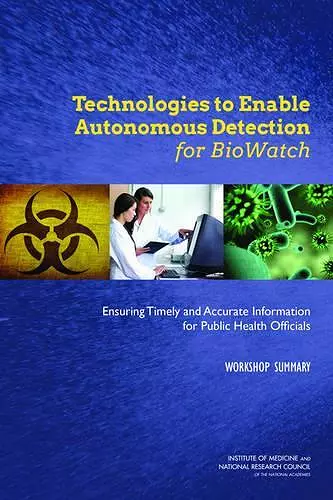Technologies to Enable Autonomous Detection for BioWatch
Ensuring Timely and Accurate Information for Public Health Officials: Workshop Summary
National Research Council author Board on Life Sciences author Institute of Medicine author Board on Health Sciences Policy author Joe Alper editor Sheena M Posey Norris editor India Hook-Barnard editor
Format:Paperback
Publisher:National Academies Press
Published:31st Jan '14
Currently unavailable, and unfortunately no date known when it will be back

The BioWatch program, funded and overseen by the Department of Homeland Security (DHS), has three main elements—sampling, analysis, and response—each coordinated by different agencies. The Environmental Protection Agency maintains the sampling component, the sensors that collect airborne particles. The Centers for Disease Control and Prevention coordinates analysis and laboratory testing of the samples, though testing is actually carried out in state and local public health laboratories. Local jurisdictions are responsible for the public health response to positive findings. The Federal Bureau of Investigation is designated as the lead agency for the law enforcement response if a bioterrorism event is detected. In 2003 DHS deployed the first generation of BioWatch air samplers. The current version of this technology, referred to as Generation 2.0, requires daily manual collection and testing of air filters from each monitor. DHS has also considered newer automated technologies (Generation 2.5 and Generation 3.0) which have the potential to produce results more quickly, at a lower cost, and for a greater number of threat agents.
Technologies to Enable Autonomous Detection for BioWatch is the summary of a workshop hosted jointly by the Institute of Medicine and the National Research Council in June 2013 to explore alternative cost-effective systems that would meet the requirements for a BioWatch Generation 3.0 autonomous detection system, or autonomous detector, for aerosolized agents . The workshop discussions and presentations focused on examination of the use of four classes of technologies—nucleic acid signatures, protein signatures, genomic sequencing, and mass spectrometry—that could reach Technology Readiness Level (TRL) 6-plus in which the technology has been validated and is ready to be tested in a relevant environment over three different tiers of temporal timeframes: those technologies that could be TRL 6-plus ready as part of an integrated system by 2016, those that are likely to be ready in the period 2016 to 2020, and those are not likely to be ready until after 2020. Technologies to Enable Autonomous Detection for BioWatch discusses the history of the BioWatch program, the role of public health officials and laboratorians in the interpretation of BioWatch data and the information that is needed from a system for effective decision making, and the current state of the art of four families of technology for the BioWatch program. This report...
ISBN: 9780309292511
Dimensions: unknown
Weight: unknown
260 pages